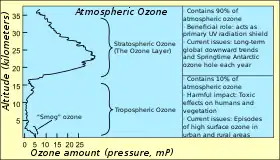Antiozonant
An antiozonant, also known as anti-ozonant, is an organic compound that prevents or retards damage caused by ozone. The most important antiozonants are those which prevent degradation of elastomers like rubber. A number of research projects study the application of another type of antiozonants to protect plants as well as salmonids that are affected by the chemicals.

Effect of ozone

Many elastomers are rich in unsaturated double bonds, which can react with ozone present in the air in process known as ozonolysis. This reaction breaks the polymer chains, degrading the mechanical properties of the material. The most obvious effect of this is cracking of the elastomer (ozone cracking), which is exacerbated by mechanical stress. The rate of degradation is effected both by the chemical structure of the elastomer and the amount of ozone in the environment. Elastomers which are rich in double bonds, such as natural rubber, polybutadiene, styrene-butadiene rubber and nitrile rubber are the most sensitive to degradation,[1] whereas butyl rubber, polychloroprene, EPDM and Viton are more resistant. Ground-level ozone is naturally present, but it is also a product of smog and thus degradation is faster in areas of high air pollution. All of these factors make vehicle tires particularly vulnerable, as they contain a high level of unsaturated groups, operate in areas prone to air pollution and are subjected to significant mechanical stresses.
Protection of elastomers
Antiozonants are used as additives in tire manufacturing to retard the effects of ozone.[2]
The most common antiozonants for elastomers are N,N′-substituted p-phenylenediamines (PPD) which can be categorized in three types:
- Dialkyl p-Phenylenediamines, such as N,N'-Di-2-butyl-1,4-phenylenediamine
- Alkyl-aryl p-Phenylenediamines, such as 6PPD[3] or IPPD[4]
- Diaryl p-Phenylenediamines, like DPPD
Other classes include:
- Styrenated phenol (SPH), styrenated and alkylated phenol (SAPH)
- Hydrocarbon waxes which create a surface barrier, preventing contact with ozone: paraffin wax, microcrystalline wax.[5]
Protection of plants
For the protection of plants like winter wheat or maize[6] Ethylene diurea (EDU) has been used successfully as antiozonant.
References
- Layer, R. W., & Lattimer, R. P. (1990). Protection of rubber against ozone. Rubber Chemistry and Technology, 63(3), 426-450.
- Hans-Wilhelm Engels et al., "Rubber, 4. Chemicals and Additives" in Ullmann's Encyclopedia of Industrial Chemistry, 2007, Wiley-VCH, Weinheim. doi:10.1002/14356007.a23_365.pub2.
- 6PPP
- IPPD Archived December 5, 2008, at the Wayback Machine (product page)
- Antioxidants & Antidegradants
- Singh, Aditya Abha; Chaurasia, Meenakshi; Gupta, Vaishali; Agrawal, Madhoolika; Agrawal, S. B. (May 2018). "Responses of Zea mays L. cultivars 'Buland' and 'Prakash' to an antiozonant ethylene diurea grown under ambient and elevated levels of ozone". Acta Physiologiae Plantarum. 40 (5): 92. doi:10.1007/s11738-018-2666-z. ISSN 0137-5881. S2CID 13832708.